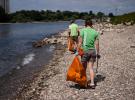Hurricane Melissa Points to Category 6 Storms as the ‘New Normal’
As climate change fuels increasingly powerful storms, scientists say the 1–5 Saffir-Simpson hurricane wind scale no longer captures their true intensity.
The death toll from Hurricane Melissa has risen to 45, with 15 people still missing. The storm, which displaced 30,000 households after it made landfall Oct. 28, was classified as a Category 5 hurricane, but it came close to a Category 6, climatologist Dr. Michael Mann, presidential distinguished professor at the University of Pennsylvania’s earth and environmental science department, told The Independent.
“I wouldn’t rule out that in post-season analysis, the wind estimates are upgraded, possibly breaching the Category 6 cut-off,” Mann said, adding that such high-powered storms are becoming the new normal and may eventually need to be reclassified.
“As long as we’re using wind-based metrics, it simply doesn’t make sense (mathematically, or fiscally and sociologically) to artificially cap the scale at 5 anymore.”
The Saffir-Simpson Hurricane Wind Scale ranks storm severity by wind speed: a Category 1 storm would sustain wind speeds of 119 to 153 kilometres per hour, while a Category 4 would reach between 209 and 251 km/h. A Category 5 storm sustains 252 km/h or higher.
Hurricane Mellisa, one of the strongest storms ever recorded in the Atlantic Ocean, packed 298 km/h winds, placing it within Category 5. But this open-ended categorization may need some updating, some experts say. Last year, a study recommended adding a Category 6 for storms with wind speeds breaching 309 km/h. Its analysis found five storms since 2013 that would fit that criterion.
Meteorologist Jeff Berardelli wrote on social media that he doesn’t “firmly feel either way” about the possible change, but added: “If we continue to see these ‘league of their own’ storms then we need a way to separate ‘the men from the boys,’ if you will.”
Others argue that changing the categorization now could complicate historical comparisons.
Dr. Katharine Hayhoe, chief scientist of the U.S. Nature Conservancy, agreed that a higher category would help recognize the greater risks of more intense storms, but suggested what’s really needed is a “full redo” of the scale to also consider precipitation.
“The argument over whether or not to add a Category 6 to the Saffir-Simpson scale actually ignores the forest for the trees because we’re now seeing that flooding damage is arguably just as [great] if not a greater issue,” Hayhoe told the Independent.
Cover photo: janeb13 / Pixabay



